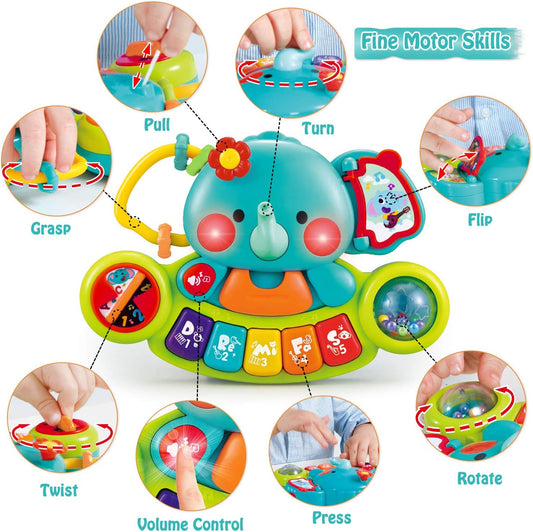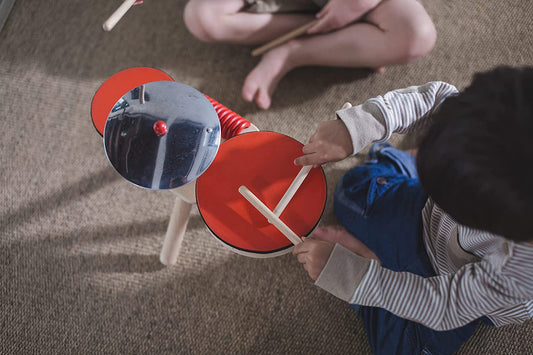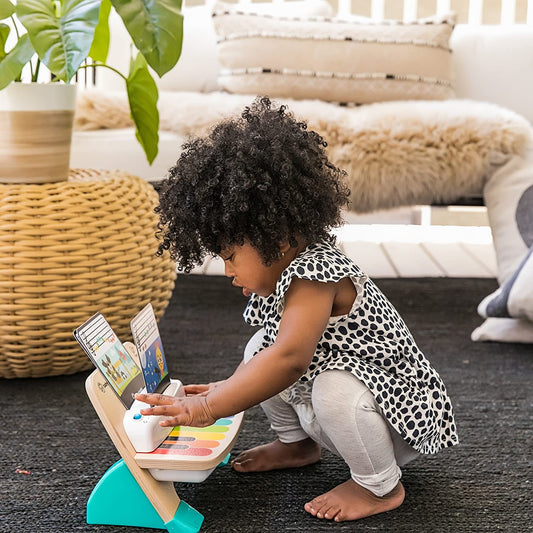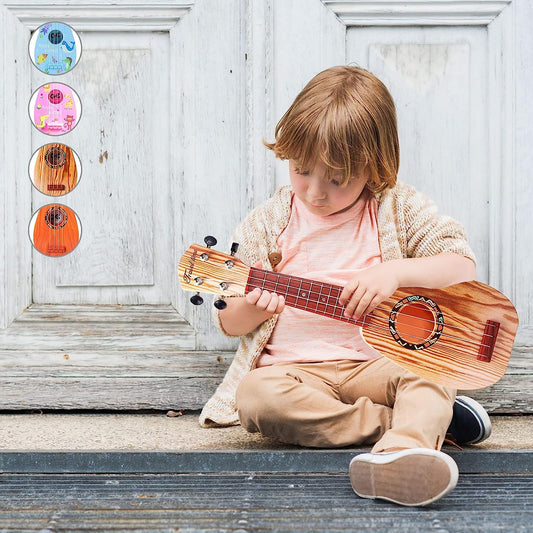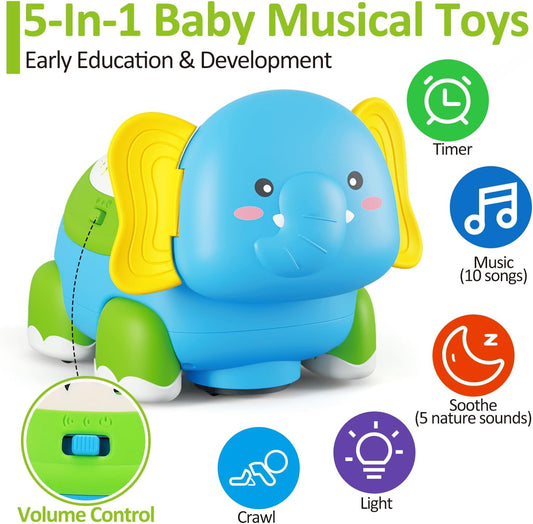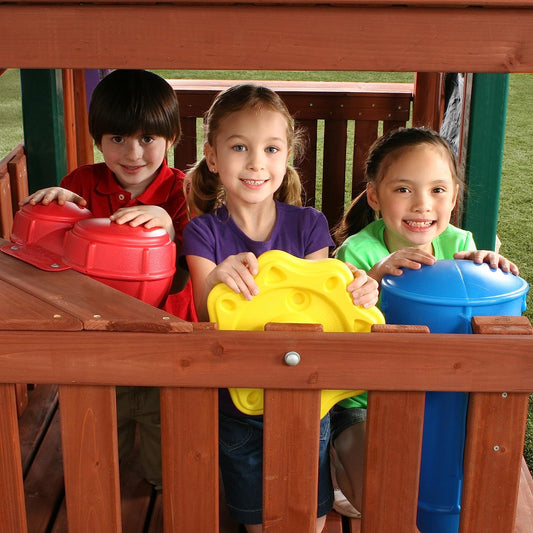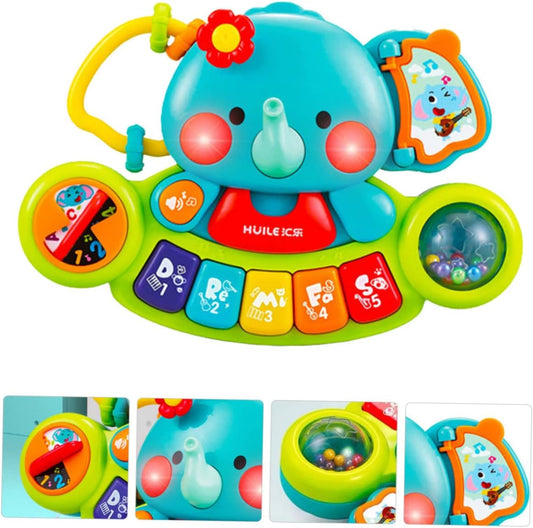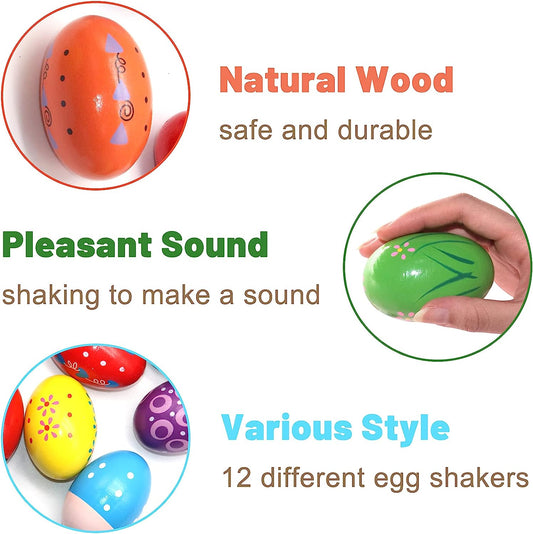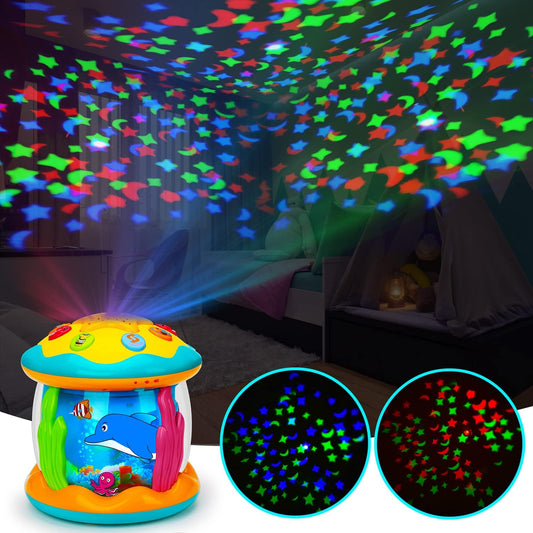-
Baby Piano Toys for 1 Year Old Boy Girl Light Up Baby Toys 6 to 12 Months Musical Learning Toys for Infant Baby Toddler 6 9 12 18 24 Months Elephant Piano Keyboard Toys Gifts for 1 2 Year Old
Regular price $20.39 USDRegular priceUnit price / per$29.56 USDSale price $20.39 USDSale -
Wooden Musical Band Toy Percussion Instrument (6410) | Sustainably Made from Rubberwood and Non-Toxic Paints and Dyes
Regular price $72.00 USDRegular priceUnit price / per$94.32 USDSale price $72.00 USDSale -
and Hape Magic Touch Piano Wooden Musical Toddler Toy, Age 6 Months and Up
Regular price $35.99 USDRegular priceUnit price / per$46.78 USDSale price $35.99 USDSale -
17 Inch Kids Ukulele Guitar Toy 4 Strings Mini Children Musical Instruments Educational Learning Toy for Toddler Beginner Keep Tone Anti-Impact Can Play with Picks/Strap/Primary Tutorial
Regular price $26.39 USDRegular priceUnit price / per$37.21 USDSale price $26.39 USDSale -
5 in 1 Crawling & Walking Baby Toys 3-6 to 12 Months Developmental Musical Toys for Babies 12-18 Months Light Up Tummy Time Infant Toys 3 6 9 6-12 Month 1 Year Old Boy Girl Toys 1st Birthday Gifts
Regular price $23.99 USDRegular priceUnit price / per$31.90 USDSale price $23.99 USDSale -
NE 4895 Outdoor Rhythm Band Swing Set Music Play Kit (Pack of 3), Multi-Colored
Regular price $56.71 USDRegular priceUnit price / per$73.73 USDSale price $56.71 USDSale -
Baby Toys Carousel Rotating Light Up Infant Toys 18+ Months, Tummy Time Toys for Babies 18-36 Months, Musical Crawling Toy for Toddlers 2 3 Years Old (Blue)
Regular price $21.59 USDRegular priceUnit price / per$25.47 USDSale price $21.59 USDSale -
1pc Piano Keyboard Toy Kids Educational Toys Kids Keyboard Baby Piano Musical Keyboard Toy Electronic Keyboard for Kids Electric Piano Toy Electric Organ Toy Electric Music Toy Abs
Regular price $22.02 USDRegular priceUnit price / per$31.05 USDSale price $22.02 USDSale -
Egg Shakers, 12Pcs Egg Shakers Musical Instruments, Egg Shakers for Babies, Easter Shaker Eggs, Wooden Baby Shaker Toy, Maracas for Toddlers 1-3, Musical Instruments(Wood)
Regular price $23.99 USDRegular priceUnit price / per$34.54 USDSale price $23.99 USDSale -
Baby Toys 6 to 12 Months 4 in 1 Musical Projector Rotating Tummy Time Learning Light Up Infant Baby Toys 0-3 3-6 9 12-18 Month Babies Toddlers 1 2 3 Year Old Boy Girl Kid Easter Gifts for Baby
Regular price $31.19 USDRegular priceUnit price / per$38.05 USDSale price $31.19 USDSale
Collection: Tune Into Fun: Your Guide To Rhythmic Play Activities
Are you ready to unleash your inner rhythm and have a blast while doing it? If the idea of rhythmic play activities sounds like child's play, think again. Engaging in these activities not only brings joy and excitement but also offers numerous benefits for both adults and children alike.
Now, some might argue that these activities are just frivolous ways to pass the time. But let me tell you, dear reader, research has shown that participating in rhythmic play can improve cognitive function, enhance coordination skills, boost creativity, reduce stress levels, and promote a sense of well-being.
So why not tap into the power of rhythm and enjoy some fun-filled playtime?
In this comprehensive guide titled 'Tune into Fun: Your Guide to Rhythmic Play Activities,' we will explore a wide range of exhilarating options that will get your heart pounding and your body moving. From dance parties to drum circles, musical scavenger hunts to body percussion; there is something for everyone.
So gear up for an adventure filled with music, movement, and pure euphoria as we dive into the world of rhythmic play activities together!
Key Takeaways
- Rhythmic play activities offer numerous benefits for both adults and children, including improved cognitive function, enhanced coordination skills, boosted creativity, reduced stress levels, and a sense of well-being.
- Dance parties and drum circles are fun ways to engage in rhythmic play and bond with loved ones, while also improving cardiovascular health, boosting mood, and enhancing coordination skills.
- Exploring rhythm through art, body percussion, and musical storytelling allows for creative expression, deeper understanding of rhythm, and relaxation.
- Rhythm therapy combines rhythm and music for self-expression and healing, activating the brain's emotion-regulating areas and promoting relaxation and stress reduction.
Dance Party: Get your groove on and create your own dance party with friends or family. Dance to your favorite songs and let the rhythm move you.
Get ready to get your groove on and create your own dance party with friends or family! It's time for a Dance Party, where you can let loose and show off your moves.
Imagine a lively atmosphere filled with laughter, music, and the sound of feet tapping to the beat. This is your chance to dance like nobody's watching and have a blast!
A Dance Party is not just about dancing; it's also an opportunity to bond with loved ones through rhythmic play. You can organize a friendly Dance Off competition, where each participant showcases their best moves in a fun-filled battle of talent. Or, if you're feeling adventurous, you can even plan a Musical Flashmob surprise for unsuspecting passersby.
Dancing has numerous benefits beyond pure enjoyment. It improves cardiovascular health, boosts mood by releasing endorphins, and enhances coordination skills. So put on your dancing shoes and let the rhythm move you!
As the energy from the dance party flows through you, it's time to transition into our next activity: Drum Circle. Grab some drums or makeshift instruments and gather a group of friends or family for an unforgettable rhythmic experience.
In this section, we will explore different rhythms and create our own beats without missing a single step!
Drum Circle: Grab some drums or makeshift instruments and gather a group of friends or family for a drum circle. Explore different rhythms and create your own beats.
Immerse yourself in the pulsating energy of a drum circle, where you and your loved ones can unleash your inner musicians and create a symphony of rhythmic bliss. Drum circles have been an integral part of cultures around the world for centuries, providing a space for people to come together and connect through rhythm.
To truly embrace the power of a drum circle, it's important to familiarize yourself with different drumming techniques. Experiment with hand placement, varying intensities, and explore different rhythms. Start by finding the beat that resonates with you and let it guide your hands as they dance upon the drums. As you gain confidence, challenge yourself to incorporate more complex patterns and syncopations.
Rhythm exploration is at the heart of a successful drum circle. Encourage each participant to listen closely to one another and find their place within the collective rhythm. By doing so, you'll be able to create intricate layers of sound that build upon one another in perfect harmony.
As you conclude your invigorating drumming session, transition into an equally exciting activity: creating a musical scavenger hunt. Hide musical instruments or objects that make sounds around your home or outdoor space. Follow the clues provided and embark on an adventure filled with hidden treasures waiting to be discovered by eager ears and curious minds.
Musical Scavenger Hunt: Create a musical scavenger hunt by hiding musical instruments or objects that make sounds around your home or outdoor space. Follow the clues and find the hidden treasures.
Embark on an exciting musical adventure by creating a scavenger hunt, hiding instruments and objects that make sounds for you to discover. Outdoor exploration takes on a whole new level of fun as you set out to find the hidden sound treasure!
Start by gathering a variety of instruments such as drums, shakers, bells, or even pots and pans. Place them strategically around your home or outdoor space, making sure they're well-hidden but still accessible.
Next, create clues that lead you from one instrument to the next. These clues can be riddles or descriptions that hint at the location of the next sound treasure. For example, "Where birds sing and leaves rustle, look beneath this shady cluster."
Follow each clue to uncover the hidden instruments and objects one by one. As you search for each sound treasure, take time to experiment with different sounds and rhythms. Play around with the instruments you find and see what unique beats you can create. Challenge yourself to improvise and explore different ways of playing each instrument.
Once you've completed your musical scavenger hunt, transition into rhythm games like Simon says or pass the rhythm. These games will test your ability to follow rhythmic patterns and add your own creative touch.
Now get ready for some rhythmic play – let's dive into the world of rhythm games!
Rhythm Games: Play rhythmic games like Simon Says, where you have to follow the rhythm of the leader's claps or beats. Or try Pass the Rhythm, where each person adds a new rhythmic pattern to the group.
Let the rhythm take control as you join in on the rhythmic fun of Simon Says or Pass the Rhythm games. These engaging activities not only provide entertainment but also help develop coordination and a sense of timing.
In Simon Says, you'll have to follow the leader's claps or beats, keeping up with their rhythm and movements. It's a great way to sharpen your listening skills while having a blast.
Another exciting game to try is Pass the Rhythm, where each person adds a new rhythmic pattern to the group. This game encourages creativity and teamwork as you work together to create an intricate rhythmic composition. You can even incorporate props like drums or shakers for added fun.
If you're looking for a team activity, consider organizing a Rhythm Relay. This involves completing different rhythmic tasks while passing a baton from one teammate to another. It's an excellent way to build camaraderie while honing your musical skills.
Additionally, exploring rhythm through art can be an enlightening experience. Try creating visual representations of different rhythms and beats using colors and patterns. This exercise allows you to express your creativity while deepening your understanding of rhythm.
Now that you've explored these exciting rhythmic games, it's time to move on to body percussion. Learn how to create unique rhythms using your body as an instrument by clapping, stomping, snapping, and slapping different parts of your body. Get ready for some hands-on rhythmic fun!
Body Percussion: Learn how to create rhythms using your body as an instrument. Clap, stomp, snap, and slap different parts of your body to create a unique rhythmic composition.
Get ready to groove with body percussion as you learn how to use your body as a rhythmic instrument, creating beats and rhythms by clapping, stomping, snapping, and slapping. Body percussion allows you to create rhythmic compositions without using any instruments, exploring the different sounds and rhythms that can be produced solely through the movements of your body.
As you delve into the world of body percussion, you'll discover the vast range of sounds that can be created. Each part of your body – from your hands and feet to your chest and thighs – can produce unique tones and rhythms. By experimenting with different techniques and combinations of movements, you can create intricate rhythmic patterns that are entirely original.
Not only is body percussion a fun activity, but it also enhances coordination skills and improves rhythmicality. As you become more proficient in this art form, you'll gain a deeper understanding of rhythm and develop a heightened sense of timing.
Now that you've mastered the art of body percussion, get ready for the next exciting adventure: musical storytelling. In this section, we'll explore how rhythm and music can be used to tell captivating stories. You'll learn how to create narratives by adding sound effects and background music to enhance the storytelling experience seamlessly.
Let's dive into this enchanting world where rhythm brings stories to life!
Musical Storytelling: Use rhythm and music to tell a story. Create a narrative and add sound effects and background music to enhance the storytelling experience.
Immerse yourself in the captivating world of musical storytelling, where rhythm and music come together to create an enchanting narrative filled with mesmerizing sound effects and captivating background music.
Soundscaping plays a crucial role in this art form, allowing you to create an immersive storytelling experience by using various sounds and music to set the scene and enhance the narrative.
Through rhythmic play activities like musical storytelling, you can explore the therapeutic benefits of rhythm therapy. This unique approach combines rhythm and music to tell a story while also serving as a powerful form of self-expression and healing.
As you weave intricate tales through sound, you unleash your creativity, release emotional tension, and find solace in the harmonious melodies that resonate within.
Research has shown that engaging in rhythmic activities can have profound effects on our well-being. It activates certain areas of the brain responsible for regulating emotions, reducing stress levels, and increasing feelings of relaxation.
By incorporating rhythm into your storytelling practice, you tap into these therapeutic benefits while crafting narratives that transport listeners on a journey they won't soon forget.
As we delve deeper into this rhythmic exploration, let's transition into exploring how rhythm intertwines with movement. Combine rhythm with movement by creating choreographed routines or improvising dance moves to different beats and rhythms...
Rhythm and Movement: Combine rhythm with movement by creating choreographed routines or improvising dance moves to different beats and rhythms.
Embark on a rhythmic adventure as you blend movement and rhythm, creating choreographed routines or improvising dance moves to the pulsating beats and captivating rhythms.
Rhythmic fitness is an exciting way to combine exercise with music, allowing you to get your heart pumping while grooving to the beat. Engaging in rhythmic yoga can also enhance your mind-body connection, promoting relaxation and improving flexibility.
As you delve into this rhythmic world, let yourself be carried away by the power of movement and rhythm. Experience the exhilaration of synchronizing your body's fluid motions with infectious melodies. Feel the energy coursing through your veins as you tap into your inner dancer.
Incorporating rhythm and movement has numerous benefits that extend beyond physical fitness. It boosts confidence by allowing you to express yourself freely through dance. It ignites joy and happiness within, uplifting your mood and providing a sense of empowerment. It fosters creativity as you explore different ways to interpret beats and rhythms through unique dance moves.
Now, imagine taking this journey further by making your own instruments using household items like cans, bottles, or cardboard. Experimenting with different materials will enable you to create unique sounds that complement your movements perfectly.
So get ready for the next section about instrument making: unleash your creativity and discover new ways to enhance the rhythmic experience without missing a beat!
Instrument Making: Get creative and make your own instruments using household items like cans, bottles, or cardboard. Experiment with different materials to create unique sounds.
Crafting your own instruments using common household items like cans, bottles, or cardboard is a creative way to explore different sounds and enhance your rhythmic experience. Rhythm exploration becomes even more exciting when you can experiment with unique sounds created by instruments you've made yourself.
By repurposing items found around the house, you can create a variety of instruments that produce different tones and rhythms. Sound experimentation is at the heart of instrument making. With just a few simple materials, you can construct drums, shakers, or even stringed instruments.
For example, an empty coffee can filled with beans or rice makes for a fantastic homemade shaker. You can also transform an old cereal box into a guitar by attaching rubber bands across the opening. The possibilities are endless!
As you craft your own instruments and delve into sound experimentation, you not only develop your creativity but also gain a deeper understanding of rhythm and how it relates to music. This hands-on approach allows you to engage all your senses as you listen to the unique sounds produced by each instrument.
Now that you've explored instrument making and sound experimentation, it's time to take your rhythmic play activities to the next level with karaoke night! Sing along to your favorite songs and add your own rhythmic twists and dance moves to make it a fun and interactive experience without missing a beat.
Karaoke Night: Sing along to your favorite songs and add your own rhythmic twists and dance moves to make it a fun and interactive experience.
Get ready to turn up the volume and join in on the ultimate karaoke night where you can sing along to your favorite tunes while adding your own unique twists and dance moves for a truly interactive experience. Karaoke night isn't just about singing; it's about creating a fun and engaging atmosphere where you can let loose and show off your rhythmic dance moves.
So grab that microphone, warm up those vocal cords, and get ready to rock the stage!
The beauty of karaoke night lies in its interactive nature. It's not just about listening to music; it's about actively participating in the performance. Singing along to your favorite songs allows you to connect with the music on a deeper level, while adding your own twists and dance moves adds a personal touch that makes it all the more special.
Whether you're belting out power ballads or grooving to upbeat tracks, karaoke night gives you the freedom to express yourself through rhythm. You can experiment with different dance styles like hip-hop, salsa, or even freestyle your way across the stage. Let your body move to the beat as you engage in an exhilarating and energetic performance.
So gather your friends or family, set up a karaoke machine or find a local venue that offers karaoke nights, and prepare for an unforgettable experience filled with laughter, joy, and plenty of memorable moments.
Now let's transition into our next activity: rhythm circle! Sit in a circle with friends or family and pass a rhythmic pattern or beat around the circle. Each person adds their own variation to create a collaborative rhythm...
Rhythm Circle: Sit in a circle with friends or family and pass a rhythmic pattern or beat around the circle. Each person adds their own variation to create a collaborative rhythm.
Join in on the rhythmic circle with your friends or family, passing the beat like a lively flame igniting each person's unique musical spark. The rhythm circle is a fun and interactive activity that allows you to explore your creativity and improvisation skills through rhythmic play.
As the beat travels around the circle, each person has the opportunity to add their own variation, creating a collaborative rhythm that is both dynamic and engaging.
The beauty of the rhythm circle lies in its variations. You can experiment with different patterns, beats, and movements, allowing everyone to contribute their own musical ideas. Whether it's clapping hands, tapping feet, or using percussion instruments, each participant adds their personal touch to the evolving rhythm.
Rhythmic play improvisation is at the heart of this activity. It encourages you to think outside the box and explore new ways of expressing yourself through music. You can try incorporating syncopated rhythms, polyrhythms, or even experimenting with different genres of music to spice up the experience.
As you delve into the world of rhythmic play within the circle, you'll develop a strong sense of timing and coordination while having an absolute blast.
So get ready to let loose and tap into your inner groove as we move onto our next exciting adventure: Musical freeze dance!
Musical Freeze Dance: Play a game of freeze dance where you dance to music and freeze when the music stops. Add a twist by incorporating different rhythms and movements for each round.
Let's kick up the energy and groove to the beat as we dive into the exciting world of Musical Freeze Dance! This rhythmic play activity combines dancing, music, and a fun twist of freezing in your tracks. But why stick to just one dance style when you can explore a variety of different movements? Get ready to unleash your inner dancer as you sway to the rhythm of salsa, stomp like a hip-hop star, or twirl gracefully with ballet-inspired moves. The possibilities are endless!
Musical Freeze Dance not only brings joy and laughter but also offers a fantastic way to stay active. In fact, many fitness enthusiasts incorporate rhythm-based classes into their workout routines. These classes fuse dance movements with high-energy beats, making it an enjoyable form of exercise that keeps you motivated and engaged.
So gather your friends or family members for an epic game of Musical Freeze Dance! With each round, challenge yourselves by incorporating different rhythms and movements. You might find yourself shimmying to Latin beats one moment and then grooving to funky disco tunes in the next.
Now that we've explored the lively world of Musical Freeze Dance, let's transition into our next rhythmic play activity: Rhythm Relay. In this exciting game, teams divide into groups and compete in a relay race where each participant must complete a rhythmic task before passing the baton to the next team member.
Rhythm Relay: Divide into teams and set up a relay race where each participant has to complete a rhythmic task before passing the baton to the next team member.
Divide into teams and get ready to feel the adrenaline rush as you race against the clock, completing rhythmic tasks in the thrilling game of Rhythm Relay. This exciting activity will test your coordination, rhythm, and teamwork skills.
Here are four variations of Rhythm Relay that will take your play experience to the next level:
-
Speed Challenge: In this variation, each team member has to complete their rhythmic task as quickly as possible before passing the baton to the next participant. The team with the fastest overall time wins.
-
Mirror Image: This twist requires teams to perform their rhythmic tasks while mirroring their teammates' movements. It adds an extra layer of complexity and coordination, challenging your ability to synchronize with others.
-
Obstacle Course: Create an obstacle course with different stations where participants have to complete various rhythmic challenges before moving on. It adds a physical element to the game and tests your agility along with rhythm.
-
Solo Play: Don't have enough players? No problem! You can still enjoy Rhythm Relay by completing all the tasks yourself in a solo race against time. Push yourself to maintain accuracy and speed throughout.
Now that you've mastered Rhythm Relay variations and experienced its exhilarating challenges, let's explore how you can combine rhythm with art by creating visual representations of different rhythms and beats using colors, shapes, and patterns without missing a beat!
Music and Art: Combine rhythm with art by creating visual representations of different rhythms and beats. Use colors, shapes, and patterns to express the music visually.
Immerse yourself in the harmonious fusion of rhythm and art by visually representing different beats and rhythms through vibrant colors, captivating shapes, and mesmerizing patterns. Artistic interpretations of music allow you to delve into a world where visual beauty meets rhythmic expression. By creating rhythm-inspired paintings, you can capture the essence of music on canvas.
When translating rhythm into art, consider the tempo, intensity, and mood of the music. Each beat can be represented by a specific color or shape that resonates with you personally. For example, a fast-paced drumbeat may be depicted with bold lines and energetic colors like red and orange. In contrast, a slow melody might inspire soft curves and soothing blues or greens.
Artistic interpretations of rhythm not only provide an outlet for self-expression but also offer a unique way to engage with music on a deeper level. By visually capturing the nuances of each beat and note, you can enhance your appreciation for the intricacies of musical composition.
Incorporating this artistic approach to rhythm can also serve as a form of meditation. As you focus on creating your rhythmic artwork, let the repetitive patterns guide your thoughts towards relaxation and mindfulness. Allow yourself to become fully absorbed in the process as you find harmony between sound and sight.
Transitioning into our next section about rhythm meditation: use rhythmic patterns and beats to guide a meditation session, let us explore how focusing on rhythm can help us achieve a state of tranquility.
Rhythm Meditation: Use rhythmic patterns and beats to guide a meditation session. Focus on the rhythm and let it help you find a state of relaxation and mindfulness.
Explore the profound tranquility of rhythm meditation as you allow rhythmic patterns and beats to guide your journey towards relaxation and mindfulness. Rhythm meditation harnesses the power of rhythmic breathing and rhythmic walking to help you achieve a state of deep calmness and focus.
✨ The Benefits: - Increased relaxation: As you synchronize your breath with the rhythm, your body naturally begins to relax, releasing tension and promoting a sense of calm. - Enhanced mindfulness: The repetitive nature of rhythm meditation helps bring your attention to the present moment, allowing you to fully immerse yourself in the experience. - Improved concentration: By focusing on the beat or pattern, you train your mind to stay focused, improving concentration skills that can be applied in various aspects of life.
�️ Rhythmic Breathing:
Engage in slow, deep breaths while matching the inhalation and exhalation with a specific beat or pattern. This promotes a sense of balance and harmony within.
�♀️ Rhythmic Walking:
Combine walking with rhythmic beats by taking deliberate steps in time with the music. This practice helps cultivate mindfulness while also providing gentle exercise for both body and mind.
Transitioning into our next section about 'rhythm jam session: gather a group of musicians or friends with instruments and have a jam session where everyone improvises and creates rhythms together. Let the music flow and enjoy the collaborative experience,' let's dive into an exciting exploration of collaborative creativity.
Rhythm Jam Session: Gather a group of musicians or friends with instruments and have a jam session where everyone improvises and creates rhythms together. Let the music flow and enjoy the collaborative experience
Now that you've experienced the calming effects of rhythm meditation, it's time to turn up the energy and get your creative juices flowing with a rhythm jam session! This lively activity brings together musicians or friends with instruments to create an exhilarating and collaborative musical experience.
Rhythm jam sessions not only provide a platform for self-expression but also offer numerous therapeutic benefits. Known as rhythm therapy, this form of musical interaction has been shown to enhance mood, reduce stress, and improve overall well-being. The rhythmic patterns and beats created during these sessions can be incredibly invigorating, allowing participants to release pent-up emotions and find a sense of freedom through their music-making.
Beyond its emotional benefits, engaging in a rhythm jam session also provides cognitive stimulation. As participants improvise and create rhythms together, they exercise their brains in a unique way. Studies have shown that this type of rhythmic play activates various areas of the brain responsible for processing math skills. In fact, research suggests that exposure to music and rhythmic activities can significantly improve mathematical abilities in children and adults alike.
So gather your friends or fellow musicians, grab your instruments, and let the music flow! Get ready for an electrifying rhythm jam session that will not only bring joy but also provide therapeutic benefits for both body and mind.
Frequently Asked Questions
Can I participate in the rhythm activities alone or do I need a group of people?
You don't need a crowd to feel the beat! Solo rhythmic play can offer numerous benefits. It allows you to explore your own unique rhythm, enhancing creativity and self-expression. Plus, it's a great stress-reliever!
However, group rhythm activities bring their own joy. They foster connection and collaboration, boosting social skills and teamwork. So whether you prefer marching to your own drum or joining a lively ensemble, there's rhythmic fun for everyone!
How can I incorporate different genres of music into the rhythm activities?
To incorporate different genres of music into rhythm activities, you can explore and get creative! Start by researching various musical styles like jazz, hip-hop, or classical. Incorporate elements from these genres into your rhythmic play activities.
This will not only add cultural diversity but also help you appreciate different types of music. Experiment with different instruments and rhythms to create a unique experience that showcases the power of musical exploration. Let your imagination run wild and have fun while discovering new beats!
Are there any age restrictions for participating in these rhythm activities?
Age restrictions for participating in these rhythm activities may vary depending on the specific activity and its complexity. However, solo participation can be a great option for individuals of all ages. For example, research has shown that even young children as young as 3 years old can benefit from engaging in solo rhythm activities like clapping or tapping along to music.
This allows them to develop their sense of rhythm and coordination at an early age, setting a strong foundation for future musical exploration.
Can I use objects other than drums or instruments for the drum circle or musical scavenger hunt?
You can definitely use unconventional objects for rhythmic play! Exploring non-musical objects for rhythm activities is a great way to get creative and add variety to your drum circle or musical scavenger hunt.
Try using everyday items like buckets, pots and pans, or even wooden spoons as makeshift drums. You'll be amazed at the unique sounds you can create and the fun you'll have while doing it!
So let your imagination run wild and experiment with different objects to enhance your rhythmic play experience.
How can I make sure I am creating the correct rhythm or beat for the rhythm games and activities?
Creating the correct rhythm or beat for rhythm games and activities can be ensured through practice and following the provided guidelines.
Timing and tempo are crucial in rhythm activities, so it's important to develop a sense of timing by listening to music and practicing with a metronome.
To improve rhythm accuracy, try clapping along with songs, playing simple rhythms on drums or other instruments, and gradually increasing the complexity.
Remember, consistency is key - keep practicing regularly to hone your rhythmic skills and enjoy the power of creating amazing beats!
